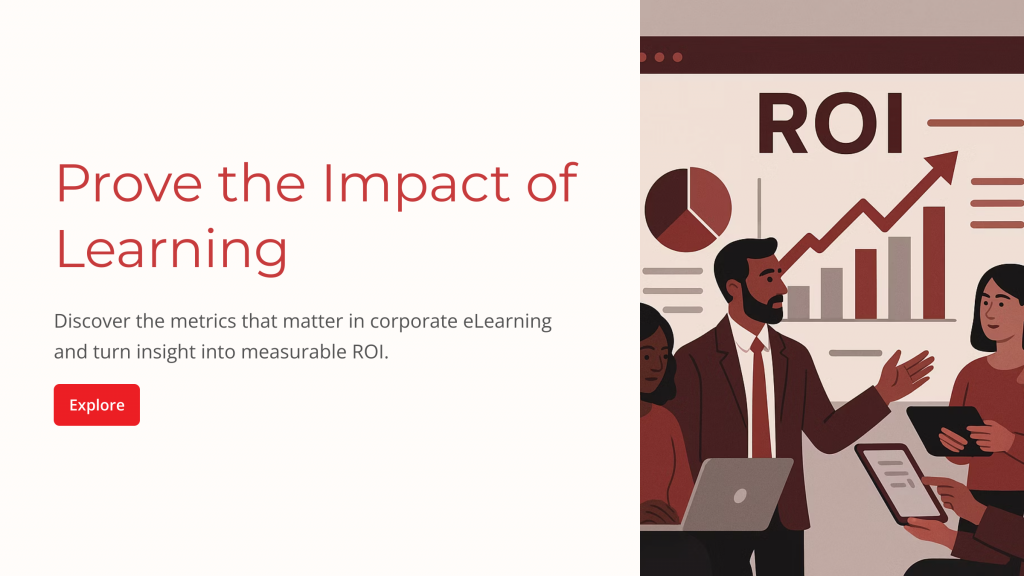
Measuring success in corporate eLearning has evolved. Tracking how many employees completed a course (or how quickly) is no longer enough to justify investment or drive strategic decisions.
Today’s learning leaders are under pressure to demonstrate tangible business outcomes: improved performance, faster onboarding, reduced error rates, and measurable gains in productivity.
Completion rates tell you who showed up. They don’t tell you who learned, who applied their skills, or what changed in your organisation as a result.
To move learning from a cost centre to a value driver, the focus must shift toward learning analytics that reflect meaningful change.
Why Does Return on Investment (ROI) Matter?
Learning and development can no longer operate in isolation from the broader business strategy. As organisations face tightening budgets and evolving workforce expectations, learning investments are expected to do more than inform. They must perform.
For corporate training managers and HR professionals, demonstrating ROI means showing how learning initiatives:
- Improve employee performance and productivity
- Accelerate time-to-competency in critical roles
- Reduce operational risks through better compliance
- Enhance retention by increasing engagement and development opportunities
- Contribute directly to revenue generation or cost reduction
Without a clear ROI strategy, even the most engaging learning experience can be undervalued (or worse, discontinued).
Core Training Effectiveness Measurements that Matter
The most valuable insights come from data that connects learning to performance, behaviour, and business outcomes.
1. Learning Retention and Application
Knowing something isn’t the same as using it. Post-training assessments, simulations, and knowledge checks help measure retention, but the real value lies in application. Are learners transferring what they’ve learned to their roles? Are they making better decisions, solving problems more effectively, or improving team dynamics? This metric closes the loop between education and execution.
2. Behavioural and Performance Shifts
Training is successful when it drives measurable change. Track performance KPIs (error reduction, quality improvements, increased sales, or faster task completion) to see how learning is influencing day-to-day behaviours. Incorporating peer feedback, manager evaluations, and 360-degree reviews can provide deeper context.
3. Operational Efficiency Gains
When learning works, processes improve. Whether it’s reducing rework, cutting downtime, or streamlining workflows, training should be linked to operational metrics. For sectors like energy, where safety and precision are critical, these efficiency gains are often the most valuable indicators of success.
4. Time to Competency
How quickly can a new hire or an upskilled employee start contributing meaningfully? Tracking time to competency helps measure the effectiveness of onboarding and reskilling efforts. A shorter ramp-up period means the learning design is working and delivering faster ROI.
5. Employee Engagement and Satisfaction
Engaged employees are more likely to stay, perform, and grow. Metrics such as course feedback scores, learner satisfaction surveys, and participation in optional learning programmes can reflect cultural alignment and motivation. Engagement also links to retention; another measurable outcome with bottom-line implications.
6. Business Impact and Financial Return
The ultimate measure: what difference did the training make to the business? This might include increased revenue, cost avoidance, improved client satisfaction, or reduced incident rates. ROI models like Kirkpatrick’s Level 4 Evaluation or the Phillips ROI Methodology offer structured ways to calculate and present these outcomes with credibility.
A Strategic Approach to Corporate eLearning Evaluation
Measuring ROI isn’t only about choosing the right metrics; it’s about building the right infrastructure to track, interpret, and act on them. A strategic evaluation approach requires more than post-course surveys or isolated dashboards. It needs seamless integration between learning delivery and performance measurement.
Anderson Studios partners with clients to embed ROI tracking into the fabric of their learning ecosystems. Through tailored Learning Management System (LMS) installation and hands-on management, we ensure every learning journey is not only measurable but meaningfully aligned with business objectives.
For learning leaders, this means less guesswork, more evidence, and a direct line between investment and improvement.
Partner with Us
When learning is strategically aligned with performance, the returns are clear: faster onboarding, stronger teams, better decision-making, and measurable business gains.
Anderson Studios works with forward-thinking organisations to make this alignment possible.
If you’re ready to elevate your learning strategy and turn insight into outcomes, we’re here to help.
Contact Anderson Studios today to schedule a discovery session and explore how our tailored solutions can deliver lasting ROI for your organisation.

